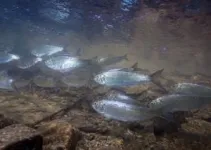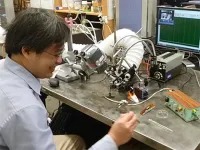(Press-News.org) Sepideh Dolatshahi, an assistant professor of biomedical engineering at the University of Virginia, is spearheading an exploration of systems immunology in its crucial development phase — during pregnancy.
Systems immunology is about unraveling concealed patterns within the human immune system, said Dolatshahi, whose approaches to her research span computational modeling, systems serology and cutting-edge spatial analysis techniques to investigate immune interactions between mother and fetus during pregnancy that could later support early childhood immunity.
Designing Tailored and Effective Vaccine Plans
Babies are immunocompromised and rely on antibodies from their mothers to protection against infections. Mothers are vaccinated during pregnancy to help increase and customize the antibodies passed on to the baby. While early vaccines such as tetanus, diphtheria and pertussis (TDAP), and recently respiratory syncytial virus (RSV), have shown astounding success, the number of vaccines available to mothers is limited and babies remain vulnerable to many pathogens.
The Dolatshahi lab is working to shed light on how vaccines given to pregnant women interact with both their changing immune system and the developing placenta to confer immune protection in the baby. The team’s goal is to design personalized vaccination strategies that can be especially beneficial to vulnerable patients, for example, those who have genetic complications or compromised immune systems.
To accomplish this, Dolatshahi and her colleagues developed the first computer-based predictive model of maternal vaccination and placental antibody transfer. This model now serves as a tool to help doctors and pre-clinical researchers test different vaccination strategies in silico before embarking on costly, tedious clinical trials, and to shorten the timeline for when patients might benefit from the resulting immunization protocols.
The Importance of Placental Development
The placenta is a protective gatekeeper that safeguards the fetus, governing which substances can reach the growing baby. Shockingly, little is known about the specifics of how the placenta regulates the passage of antibodies from mother to baby.
To shed light on this process and understand which interactions are responsible for conferring transfer of protective antibodies to the baby, Dolatshahi’s team is taking a closer look at the important molecules expressed by placental cells and how they work together to transport antibodies.
By examining this specific process using spatial analysis tools, they hope to uncover information that will identify new targets of maternal vaccines that will maximize the benefit to the baby.
Uncovering Variability Across the Population
During pregnancy the mother’s immune system is in constant flux, so there is no reason to believe that vaccination during pregnancy should be a one-size-fits-all approach. Dolatshahi and her team hope to uncover key variables affecting placental antibody transfer that might contribute to differences across the population.
By defining what causes some babies to receive more maternal antibodies than others, Dolatshahi’s work will help doctors identify patients who may benefit from specially designed vaccines to best support their baby’s immune system. More broadly, this investigation will shed light on the biological and socioeconomic factors which make some women more prone to immune-related pregnancy complications.
This research stands as a milestone to understanding the nuances of how maternal antibodies traverse the placenta and confer protection in newborn babies, and to uncovering specific immune-related mechanisms of pregnancy complications such as preterm birth and preeclampsia. Dolatshahi's research sets the stage for a more profound comprehension of the immune system’s behavior during pregnancy, offering a promising trajectory for further advancements in this critical domain.
The team's publication about this research, Quantitative mechanistic model reveals key determinants of placental IgG transfer and informs prenatal immunization strategies, has been accepted for publication by PLOS Computational Biology.
END
UVA biomedical engineer unveils the dynamics of maternal immune responses
2023-12-15
ELSE PRESS RELEASES FROM THIS DATE:
Novel therapeutic target overcomes resistance to radiation therapy
2023-12-15
A new study finds that radiation therapy (RT) suppresses a key protein called bone morphogenetic protein and activin membrane-bound inhibitor (BAMBI) and activates immune suppressive cells. These effects dampen the capacity of cancer-fighting immune cells and decrease the effectiveness of radiation, inducing therapy resistance in cancer patients, according to a paper published December 15, 2023 in the Journal of Clinical Investigation.
Radiation therapy is a common cancer treatment that kills cancer cells and activates immune cells to fight cancer. Yet this process also ...
Understanding atmospheric flash droughts in the Caribbean
2023-12-15
The word “drought” typically conjures images of parched soil, dust-swept prairies, depleted reservoirs, and dry creek beds, all the result of weeks or seasons of persistently dry atmospheric conditions.
In the sun-soaked islands in the Caribbean, however, drought conditions can occur much more rapidly, with warning signs appearing too late for mediation strategies to limit agriculture losses or prevent stresses on infrastructure systems that provide clean water to communities.
Such occurrences – known as flash droughts – are the focus of a new paper authored by Assistant Professor Craig Ramseyer of the College of Natural Resources ...
Pesticides and adjuvants disrupt honey bee’s sense of smell
2023-12-15
It has long been known that exposure to pesticide sprays is harmful to honey bees. In a new study, researchers have uncovered the effect of such sprays on the sense of smell in bees, which could disrupt their social signals.
Honey bees live in dynamic communities and constantly communicate with each other using chemicals that serve as social cues. For example, nurse bees—that are responsible for taking care of larvae that ultimately become queens and worker bees—constantly monitor the ...
Immune cells shape lung before birth and provide new avenues for treating respiratory diseases
2023-12-15
Immune cells play an active and intimate role in directing the growth of human lung tissue during development, researchers find, revolutionising our understanding of early lung development and the role of immune cells outside of immunity.
The research offers new insights for understanding and treating respiratory conditions, such as chronic obstructive pulmonary disease (COPD). Respiratory conditions account for almost 20 per cent of all deaths in children under five years worldwide1.
The work reveals a surprising coordination between the immune and respiratory systems, much earlier in development than previously thought. This discovery raises questions about the ...
Rembrandt broke new ground with lead-based impregnation of canvas for The Night Watch
2023-12-15
New research has revealed that Rembrandt impregnated the canvas for his famous 1642 militia painting ‘The Night Watch’ with a lead-containing substance even before applying the first ground layer. Such lead-based impregnation has never before been observed with Rembrandt or his contemporaries. The discovery, published today in Science Advances, underlines Rembrandt's inventive way of working, in which he did not shy away from using new techniques.
The surprising observation is yet another result from Operation Night Watch, the largest and most wide-ranging research and conservation project in the history ...
SFU and UBC researchers receive $1.25 million to study cumulative effects on B.C. salmon
2023-12-15
Salmon researchers from British Columbia are embarking on a three-year study to understand and help mitigate the cumulative threats affecting the vulnerable species in the province’s watersheds.
The Watershed Futures Initiative, which includes researchers from Simon Fraser University, University of British Columbia and University of Montana, has received $1.25 million from the federal and provincial governments – through the joint British Columbia Salmon Restoration and Innovation Fund – to tackle the combined impacts of logging, mining, urban development, agriculture, climate change and other factors on salmon.
While ...
Endocrine-disrupting chemicals found in menstrual products including tampons, pads, and liners
2023-12-15
The average menstruator will use over 11,000 tampons or sanitary pads in their lifetime. Vaginal and vulvar tissue that touch pads and tampons is highly permeable. Through this permeable tissue chemicals are absorbed without being metabolized, which makes endocrine-disrupting chemicals potentially dangerous when found in menstrual products. Endocrine-disrupting chemicals can interfere with human hormones and cause medical issues, including gynecological conditions such as endometriosis and uterine fibroids.
Joanna Marroquin, a Mason PhD in Public Health student, and Associate ...
Five researchers named Argonne Distinguished Fellows for 2023
2023-12-15
The U.S. Department of Energy’s (DOE) Argonne National Laboratory has named five highly accomplished scientists as Argonne Distinguished Fellows in 2023. They are Glenn Decker, Paul Fenter, Robert Fischetti, Sven Leyffer and Valentine Novosad.
The honor recognizes scientists who have not only achieved international esteem but who have also demonstrated exceptional achievements in science or engineering relevant to Argonne’s core missions. They are leaders of major, complex, high-priority projects or programs that have an impact on the future of the Laboratory. Only a small ...
Study shows exposure to household chemicals can lower odds of getting pregnant
2023-12-15
Exposure to phthalates, a group of plasticizing and solvent chemicals found in many household products, was linked to a lower probability of getting pregnant, but not to pregnancy loss, according to research by a University of Massachusetts Amherst environmental and reproductive epidemiologist.
The study, published this week in the journal Environmental Health Perspectives, also noted an association between preconception exposure to phthalates and changes in women’s reproductive hormones, as well as increased inflammation and oxidative stress.
“Phthalates ...
NRL’s Debra Rolison elected 2023 National Academy of Inventors Fellow
2023-12-15
WASHINGTON – Debra Rolison, Ph.D., of the U.S. Naval Research Laboratory (NRL) has been named Fellow of the National Academy of Inventors (NAI), for having demonstrated a highly prolific spirit of innovation in creating and facilitating outstanding inventions that have made a tangible impact on the quality of life, economic development, and welfare of society.
Rolison has been at the lab for over 43 years and heads the Advanced Electrochemical Materials section. The recognition by the NAI is attributed to the efforts made by her team’s inventions related to a new form factor for zinc anodes in rechargeable ...







